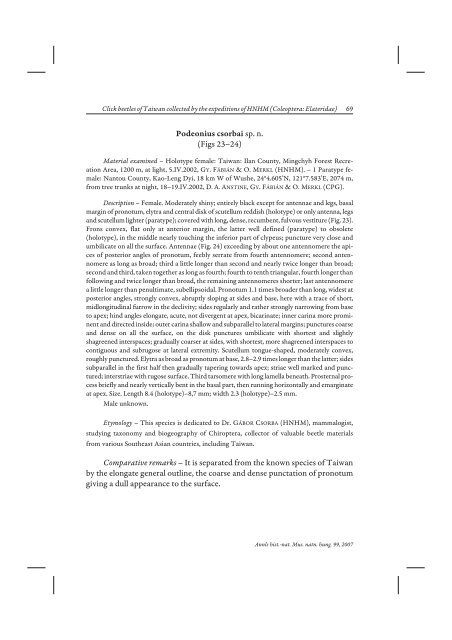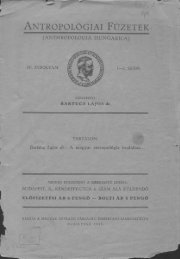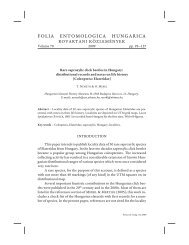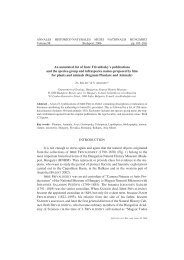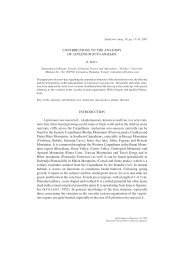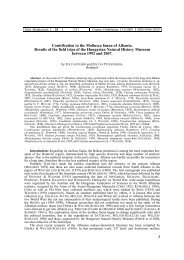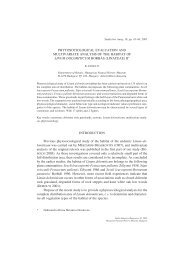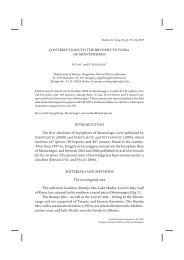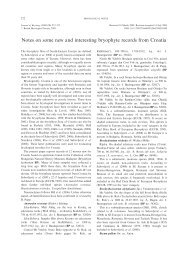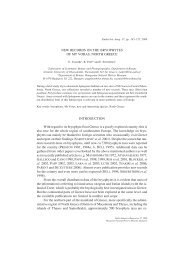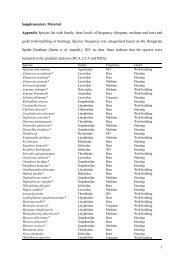Create successful ePaper yourself
Turn your PDF publications into a flip-book with our unique Google optimized e-Paper software.
Click beetles of Taiwan collected by the expeditions of HNHM (Coleoptera: Elateridae) 69Podeonius csorbai sp. n.(Figs 23–24)Material exam<strong>in</strong>ed – Holotype female: Taiwan: Ilan County, M<strong>in</strong>gchyh Forest RecreationArea, 1200 m, at light, 5.IV.2002, GY. FÁBIÁN &O.MERKL (HNHM). – 1 Paratype female:Nantou County, Kao-Leng Dyi, 18 km W of Wushe, 24°4.605’N, 121°7.583’E, 2074 m,from tree trunks at night, 18–19.IV.2002, D. A. ANSTINE, GY. FÁBIÁN & O. MERKL (CPG).Description – Female. Moderately sh<strong>in</strong>y; entirely black except for antennae and legs, basalmarg<strong>in</strong> of pronotum, elytra and central disk of scutellum reddish (holotype) or only antenna, legsand scutellum lighter (paratype); covered with long, dense, recumbent, fulvous vestiture (Fig. 23).Frons convex, flat only at anterior marg<strong>in</strong>, the latter well def<strong>in</strong>ed (paratype) to obsolete(holotype), <strong>in</strong> the middle nearly touch<strong>in</strong>g the <strong>in</strong>ferior part of clypeus; puncture very close andumbilicate on all the surface. Antennae (Fig. 24) exceed<strong>in</strong>g by about one antennomere the apicesof posterior angles of pronotum, feebly serrate from fourth antennomere; second antennomereas long as broad; third a little longer than second and nearly twice longer than broad;second and third, taken together as long as fourth; fourth to tenth triangular, fourth longer thanfollow<strong>in</strong>g and twice longer than broad, the rema<strong>in</strong><strong>in</strong>g antennomeres shorter; last antennomerea little longer than penultimate, subellipsoidal. Pronotum 1.1 times broader than long, widest atposterior angles, strongly convex, abruptly slop<strong>in</strong>g at sides and base, here with a trace of short,midlongitud<strong>in</strong>al furrow <strong>in</strong> the declivity; sides regularly and rather strongly narrow<strong>in</strong>g from baseto apex; h<strong>in</strong>d angles elongate, acute, not divergent at apex, bicar<strong>in</strong>ate; <strong>in</strong>ner car<strong>in</strong>a more prom<strong>in</strong>entand directed <strong>in</strong>side; outer car<strong>in</strong>a shallow and subparallel to lateral marg<strong>in</strong>s; punctures coarseand dense on all the surface, on the disk punctures umbilicate with shortest and slightlyshagreened <strong>in</strong>terspaces; gradually coarser at sides, with shortest, more shagreened <strong>in</strong>terspaces tocontiguous and subrugose at lateral extremity. Scutellum tongue-shaped, moderately convex,roughly punctured. Elytra as broad as pronotum at base, 2.8–2.9 times longer than the latter; sidessubparallel <strong>in</strong> the first half then gradually taper<strong>in</strong>g towards apex; striae well marked and punctured;<strong>in</strong>terstriae with rugose surface. Third tarsomere with long lamella beneath. Prosternal processbriefly and nearly vertically bent <strong>in</strong> the basal part, then runn<strong>in</strong>g horizontally and emarg<strong>in</strong>ateat apex. Size. Length 8.4 (holotype)–8,7 mm; width 2.3 (holotype)–2.5 mm.Male unknown.Etymology – This species is dedicated to Dr. GÁBOR CSORBA (HNHM), mammalogist,study<strong>in</strong>g taxonomy and biogeography of Chiroptera, collector of valuable beetle materialsfrom various Southeast Asian countries, <strong>in</strong>clud<strong>in</strong>g Taiwan.Comparative remarks – It is separated from the known species of Taiwanby the elongate general outl<strong>in</strong>e, the coarse and dense punctation of pronotumgiv<strong>in</strong>g a dull appearance to the surface.Annls hist.-nat. Mus. natn. hung. 99, 2007


